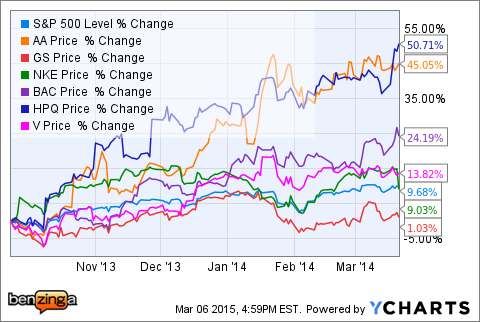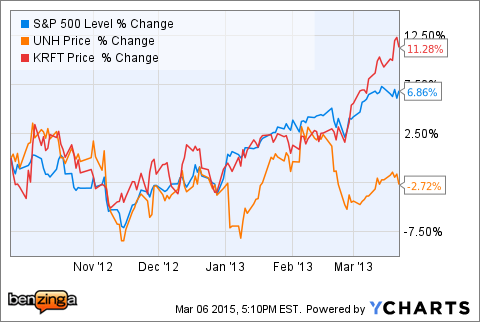There was big news for the Dow Jones Industrial Average on Friday, as the largest corporation in the world, Apple Inc AAPL 0.15% will be joining the exclusive 30-member club by taking the spot of AT&T Inc T 1.53%.
This is certainly good for the reputation of Apple as a blue-chip stock, and the move likely doesn’t do much good for AT&T’s public image. However, does the transition really matter for shareholders?
Here’s a look at how the other transitions the Dow has made in the past five years have worked out for shareholders in the six months following the move.
2013 Shuffle
The last batch of changes to the Dow took place on September 23, 2013 when former members Alcoa Inc AA 0.7%, Bank of America BAC 1.37% and Hewlett-Packard Co HPQ 2.41% were replaced by new members The Goldman Sachs Group Inc GS 1.67%, Nike Inc NKE 1.57% and Visa Inc V 1.75%.
Here’s a look at how the stocks performed following the transition:

Interestingly, the three top-performing names of the bunch were the three names that left the Dow. In fact, all three former members more than doubled the return of the S&P 500 in the six months following their Dow departure. Two of the three new Dow members lagged the S&P 500 during that same stretch.
2012 Adjustment
Prior to the 2013 membership change, the only change to the Dow in the past five years was the September 2012 addition of UnitedHealth Group Inc UNH 1.66% and exit of Kraft Foods Group Inc KRFT 1.71%.

Once again, the big winner following the transition was the stock that was booted from the index, as Kraft outperformed the S&P by a wide margin while UnitedHealth lagged the market and even produced a negative return following the transition.
Will The Pattern Hold?
Only time will tell whether this counter-intuitive pattern will hold for Apple and AT&T. So far this year, Apple stock has surged nearly 15 percent, while AT&T is slightly down year-to-date.
Read this article and all my other articles for free on Benzinga by clicking here
Want to learn more about the stock market? Or maybe you just want to be able to look sophisticated in front of your coworkers when they ask you what you are reading on your Kindle, and you’d prefer to tell them “Oh, I’m just reading a book about stock market analysis,” rather than the usual “Oh, I’m just looking at pics of my ex-girlfriend on Facebook.” For these reasons and more, check out my book, Beating Wall Street with Common Sense. I don’t have a degree in finance; I have a degree in neuroscience. You don’t have to predict what stocks will do if you can predict what traders will do and be one step ahead of them. I made a 400% return in the stock market over five years using only basic principles of psychology and common sense. Beating Wall Street with Common Sense is now available on Amazon, and tradingcommonsense.com is always available on your local internet!


